- Home
- Omega acids
- Omega-3 fatty acids for athletes
Omega-3 acids for athletes: what they give, how much to take and what effects
Omega-3 fatty acids are a useful dietary supplement for active people - improves performance and fitness.


Learn more about our editorial process
.

Learn more about our editorial process
.

Learn more about our editorial process
.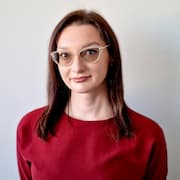

Learn more about our editorial process
.
Why you can trust us
Articles on Natu.Care are written based on scientific research, data from government websites and other reliable sources. The texts are written in cooperation with doctors, nutritionists and other health and beauty experts. Articles are reviewed before publication and during significant updates.
.Learn more about our editorial process
.Information about advertisements
Content on Natu.Care may contain links to products from the sale of which we may receive a commission. When creating content, we adhere to high editorial standards and take care to be objective about the products discussed. The presence of affiliate links is not dictated by our partners, and we select the products we review ourselves completely independently.
.Learn more about our terms and Conditions
.I know what it's like when you want to squeeze as much as you can out of your workout - faster, more and more effectively. Some dietary supplements can realistically help you do just that.
Whether you're doing cardio, throwing on the pounds, or gaining the next step up in martial arts - omega-3 fatty acids should have an important place in your sports stack.
.
From this article you will learn:
.- How omega-3 fatty acids support athletes. .
- How much and how to use them. .
- What other health benefits omega-3 fatty acids provide. .

Sprawdź, za co pokochały go tysiące klientek Natu.Care Premium Omega-3ᵀᴳ -15% z kodem BLOG15
Natu.Care Omega-3ᵀᴳ Premium
Natu.Care Omega-3ᵀᴳ Premium dla zdrowia serca, mózgu i odporności. Najlepsza przyswajalność. Optymalna dawka 750 mg. Przebadana przez niezależne laboratorium.
Zobacz więcej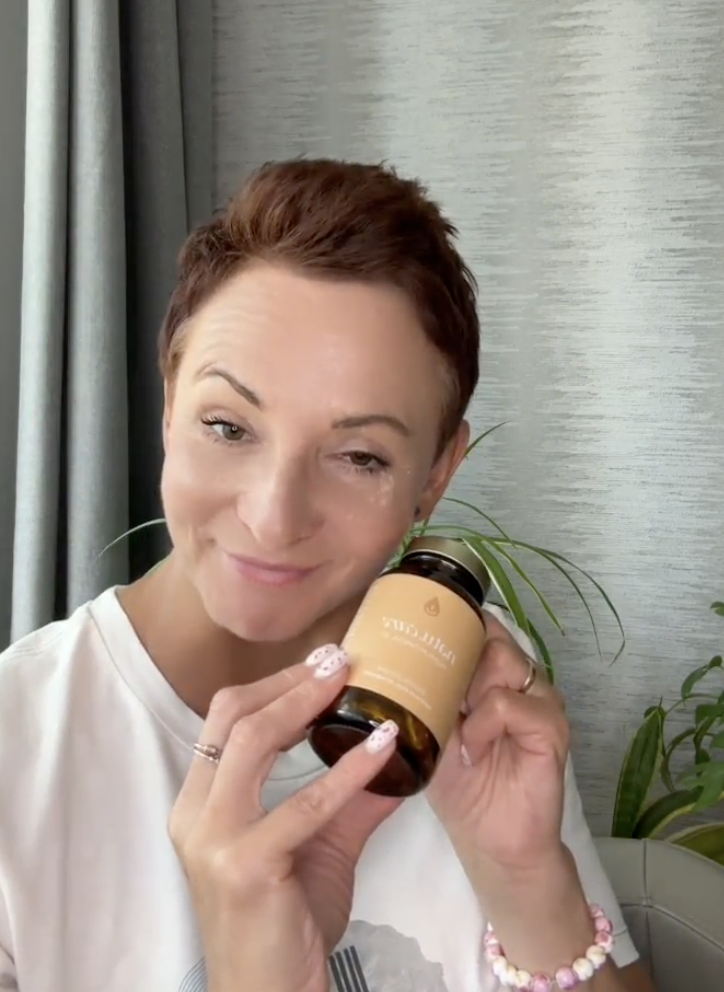
Produkt ma super skład, transparentną etykietę i co dla mnie jest ważne – małe kapsułki do połknięcia. Nie ma też nieprzyjemnego efektu odbijania rybą, który miałam spożywając inne produkty. Widzę znaczną poprawę odporności. Polecam!@Kasia P.
See also:
.
- Guide: how to choose omega-3 acids? .
- Deficiency of omega-3 fatty acids
- Omega-3 fatty acids
- Omega 3-6-9 acids
- DHA acid .
- EPA acid
- ALA acid .
The diet of an athlete
.
Physically active people need to look after more than just protein and carbohydrates in their diet. Although it is these nutrients that seem to dominate conversations about athletes' menus, because proteins build muscle mass, and carbs are the 'fuel' for training...
.
...it fats are still important in this dietary jigsaw. T here is also a great source of energy, as well as support for the absorption of the important vitamins that dissolve in them (A, D, E, K). Adequate supply and distribution of all macronutrients affects health and sports performanceand.
Physically active people should tailor macro to themselves, but the starting point is to consume nutrients in the following amounts:
.
- protein - 1.8-2.4 g/kg body weight, .
- fat - 0.8-1.2 g/kg body weight, .
- carbohydrates - remaining amount, .
For example, an 85 kg footballer with a daily requirement of 4,000 kcal should eat 153 g of protein, 85 g of fats and 655 g of carbohydrates.
As an example, an 85 kg footballer with a daily requirement of 4,000 kcal should eat 153 g of protein, 85 g of fats and 655 g of carbohydrates.
When it comes to fats, an athlete's best buddies are the so-called healthy fats, i.e. omega acids, especially those of the omega-3.
group.
Omega-3 acids - your wingmen
.
At least 80% of athletes use at least one ergogenic supplement to enhance physical and mental performance, improve performance and efficiency, and speed up recoveryand. Among these should be omega-3 fatty acids.
Omega-3 fatty acids (also known as n-3) belong to the polyunsaturated fatty acids - PUFAs ( polyunsaturated fatty acids). They are essential for your body to function properly, so you need to provide them with your diet.
There are 11 omega-3 fatty acids, but for you the most important are:
.
These three fatty acids are favourites of scientists. There has been a plethora of research involving them, and the results so far suggest that an adequate supply of omega-3 fatty acids in the diet canand:
- .
- support systems such as cardiovascular, nervous, immune, movement, .
- influence well-being and protect against the development of mental disorders, .
- help in the treatment of many diseases (e.g. autoimmune diseases), .
- improve fertility, .
- act as an anti-inflammatory, .
- promote the condition of the skin, hair and nails, .
An interesting area is also the effect of omega-3 fatty acids on sports performance, post-workout recovery and immunity. These issues will be of particular interest to all those who are physically active. Let us take a closer look at them. What do the scientific findings so far suggest?
Omega-3 fatty acids potentially:
.
Improve performance
.
Performance is the body's ability to perform prolonged physical activity or exertion without excessive fatigueand.
Omega-3 fatty acids have a vasodilatory effect on blood vessels, increasing oxygen flow during exercise, which can improve the body's performance. This was tested in a research study involving 20 moderately trained men. Prior to the study, their performance was tested on an ergometer bike.
The men were then divided into two groups in which they took either a placebo or 3.6 g of fish oil for eight weeks. After this time, their performance was tested again. They found that n-3 supplementation improved exercise economy and reduced feelings of fatigueand.
Expert comment:
.
If your main focus is endurance sports then omega-3 fatty acids will be the base of supplementation. In such cases I usually recommend 1-2 g of them (EPA+DHA) per day depending on the training period..
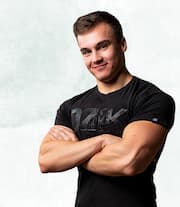 .
.
Kuba Pągowski clinical dietitian
Exercise smartly
.Exercise economy means using energy sparingly and efficiently during different activities. The idea is to perform the activity with minimum effort and fatigue. If you run with incorrect technique, for example, you waste a lot of energy, which leads to faster fatigue.
Reduce post-workout muscle soreness
.
DOMS (pronounced Delayed Onset Muscle Soreness) is delayed muscle soreness that occurs 12-48 hours after an intense or 'new' workout for the muscles. During eccentric muscle work, when muscles are stretched, there is micro-damage to the muscle fibres. Symptoms of DOMS include pain, stiffness, tenderness and muscle weakness. These complaints resolve spontaneously within a few daysand.
DOMS can discourage you from doing another workout because of the discomfort they cause or they can worsen performance - a sore muscle will not work as effectively. That's why, in addition to light recovery exercises or massages, it's worth checking how an supplementation with omega-3 fatty acids will work for you.
Study from 2017
.
The study involved 21 untrained, young men. They were divided into two groups. They took 2.4 g of fish oil (600 mg EPA + 260 mg DHA) or a placebo for eight weeks and then performed six series of 10 repetitions of forearm flexion (a popular biceps exercise).
The group taking 2.4 g of fish oil (600 mg EPA + 260 mg DHA) or a placebo then performed six series of 10 repetitions of forearm flexion (a popular biceps exercise).
The group taking EPA + DHA reported less post-workout muscle soreness. In addition, consumption of fish oil prevented temporary loss of muscle strength compared to placebo. It's those 2-3 days after a workout when you feel DOMS and can't train effectively due to discomfortand.
Study from 2016
.
Similar results were shown in an experiment involving 19 untrained women. They were divided into two groups - one took 3,000 mg of EPA and 600 mg of DHA for 14 days and the other a placebo. Supplementation significantly reduced the severity of DOMS after biceps and knee extension exercises, compared to placeboand.
Expert commentary:
.
Omega-3 fatty acids, due to their powerful anti-inflammatory effects, significantly reduce the aforementioned DOMS, however, it is worth exercising common sense, as at this point we do not know whether supplementing omega-3 fatty acids peri-workout - if your goal is to build muscle mass and strength - will be entirely optimal..
 .
.
Kuba Pągowski clinical dietitian
.
Promote recovery
.
For an athlete, recovery is as important as a strong workout. When the body rests, there are many processes going on in the body that affect how much you can lift or how long you can cycle at maximum heart rate. This is why how recovery takes place is so important.
Review of 2023 studies
.
The review looked at how n-3 affects muscle recovery and healing, as well as acute, chronic inflammationand.
Cumulative scientific evidence suggests that omega-3 fatty acids and their lipid mediators (which play a role in inflammatory processes) have the potential to enhance muscle recovery by positively modulating the inflammatory response to muscle damage.
Research from 2018
.
Twenty professional rugby players supplemented with 551 mg EPA + 551 mg DHA or placebo twice daily for five weeks. The results showed that n-3 supplementation resulted in moderate beneficial effects on lower body muscle soreness, improved maintenance of long jump performance and reduced fatigue during trainingand.
Research from 2016
.
Sleep is your recovery base - often neglected. The fast pace of life and lack of sleep hygiene do not work well for nightly 'battery recharging'.
In 2016, researchers surveyed 677 residents of Atahualpa, Ecuador. The respondents were asked about fish consumption and sleep, among other things. They found that the higher the fish consumption, the better the sleep quality score of the respondents. The average amount of oily fish in their diet was 840-1260g per weekand.
Expert comment:
.
If you have a lot of training in a week - or even several units in one day - then supplementation with these acids will be essential. They will allow you to recover faster and continue progressing..
 .
.
Kuba Pągowski clinical dietitian
.
Improve training effectiveness
.
A good pump at every workout motivates you, and when you're done - you're already thinking about the next one. And that's when DOMS, fatigue or muscle micro-damage get in the way... It's well known that you need to take care of recovery, and omega-3 fatty acids can make a valuable contribution to the effectiveness of your workout.
Study of 2023
.
The study involved 21 recreational strength-training subjects. They were divided into two groups and consumed 2.2 g EPA + 1.5 g DHA or a placebo. For 10 weeks of supplementation, they also performed strength training three times a week incorporating seven common exercises.
The study also included the following exercises.
Results suggest that DHA and EPA supplementation improved whole-body strength to a greater extent than was observed in the placebo group. Subjects showed an increase in 1-RM ( One Repetition Maximum) - the maximum load you are able to lift when performing one repetition of a given exerciseand. You know how satisfying it is when you can that one more repetition.
The 2020 study
.
In this study, alpha-linolenic acid (ALA) came under the magnifying glass. The researchers looked at how its consumption affected a group of 24 professional skiers aged 18-33 years. They looked at their health, blood n-3 concentrations, training and eating habits. The men took an average of 1.1-1.3 g of alpha-linolenic acid per day.
After fitness testing, ALA acid intake of 1-2 g per day was found to be associated with higher MFO ( Maximal Fat Oxidation). MFO refers to the level at which the body is most efficient at using fat as an energy source during physical activityand.
People with higher MFO are able to use more fat as an energy source, which helps delay muscle glycogen utilisation and prevent fatigue .
Study of 2019
.
Two trained men were divided into two groups: one took a placebo and the other 1 g EPA + 1 g DHA. They followed a low-calorie diet for six weeks - an important detail, as anyone who has been on a reduction regimen knows how training efficiency then drops and how difficult it is to maintain previous performanceand.
Results suggest that the use of DHA + EPA during weight reduction promotes maintenance or improves exercise performance. The men tested their strength in leg exercises - if you've felt at least once in your life that leg day is fun day, then you know it's a very good exercise to test your effectiveness.
Expert commentary:
Omega-3 fatty acids will also find their use in building strength, their valuable properties can help to maintain it, even during tough reduction periods. Here, I similarly often recommend around 1 g EPA+DHA per day..
 .
.
Kuba Pągowskiclinical dietitian
.
Promote muscle protein formation
.
There is nothing more enjoyable than adding weight and making a systematic progression of strength. And omega-3 fatty acids can be quite helpful in this. Maybe taking them alone won't increase the girth of your biceps (let alone your calves, sorry), but they will promote the formation of that "base".
Study from 2012
.
Nine men took 1.8 g EPA + 1.5 g DHA for eight weeks.
Nine men took 1.8 g EPA + 1.5 g DHA for eight weeks.
Supplementation had a beneficial effect onand:
- signalling of mTOR, .
- anabolic response of muscle protein synthesis and muscle cell size (protein to DNA ratio), .
- protein concentration, .
Activation of the mTOR pathway plays a key role in the muscle growth process. More active mTOR means increased muscle protein synthesis, which translates into increased muscle volumeand.
Expert commentary:
.
Want more muscle? Regular stimulation of muscle protein synthesis will do its part. And it just so happens that omega-3 supplementation promotes this condition and can keep you in a so-called anabolic environment most of the day..
 .
.
Kuba Pągowskiclinical dietitian
.
Promotes maintenance of muscle mass
.
After the age of 30, muscle mass decreases by 0.1-0.5% per year. What's more, this process accelerates significantly after the age of 65and. Of course, this doesn't mean you won't build muscle mass in your 30s. You will build, taking care with a supply of protein and suitably heavy weight trainingand. And omega-3 fatty acids can further support you.
Study of 2019
.
Two female participants took 2.97 g EPA + 2.03 g DHA every day for four weeks. They also had their leg immobilised for a fortnight. The results showed that supplementation with omega-3 fatty acids attenuates skeletal muscle atrophy (atrophy) during unilateral leg immobilisation. This was demonstrated by the cross-sectional area and volume of the quadriceps muscle on MRI. In addition, a muscle biopsy was performed, a blood sample was taken and leg strength measurements were checkedand.
When a muscle is not used - it atrophies. For your body, it's unnecessary weight. Atrophy is an affliction of all active people with injury, fracture or prolonged infection.
Research involving seniors
.
A 2017 study found that daily supplementation with 2.7 g EPA and 1.2 mg DHA significantly increased muscle growth after exercise in older adults (65-85 years), compared to younger adults (18-35 years)and.
The 2015 study involved 44 seniors aged 60-85. They were divided into two groups, with one consuming 1.8g of EPA and 1.5 DHA per day and the other a placebo. The subjects performed exercises that tested, among other things, grip strength and maximum muscle strength per repetition. Thigh muscle volumeand were also measured.
The results suggest that 6-month n-3 therapy had a statistically and clinically significant beneficial effect on thigh muscle volume, grip strength and upper as well as lower body muscle strength. There was also an increase in 1-RM - that is, the subjects could do more.
In the 2017 study, fifty subjects (27 men and 23 women aged 65+) were divided into two groups and consumed either a placebo or 2.1 g EPA + 0.6 DHA daily for 18 weeks. In addition, they did strength training twice a week.
This is the first scientific paper to show that supplementation with omega-3 n-3 PUFA fatty acids increases strength and muscle quality in older women, but... not in older menand.
.
Expert commentary:
.
Sarcopenia in old age is a nightmare. Ensuring an adequate supply of omega-3s can be important to preserve as much muscle as possible - even without training. This is especially important for our parents or grandparents. In practice, I often recommend around 1.5g EPA + DHA per day for such people, but before supplementation it is worth keeping an eye on the kidneys, which are often less efficient in the elderly..
 .
.
Kuba Pągowski clinical dietitian
.
Support the skeletal system
.
A healthy skeletal system is a strong scaffolding for an athlete. It withstands pressures, impacts and weights. A review of 2020 studies suggests that people with a higher intake of omega-3 fatty acids may have higher bone mineral densityand.
A higher density means there are more minerals in the spongy structure of the bones, such as calcium and phosphorus. This makes them stronger and more resistant to fracture. People with low bone mineral density (e.g. osteopenia or osteoporosis), are more likely to have fracturesand.
Other studies suggest that n-3 inhibits the activity of osteoclasts, the cells responsible for bone breakdown in osteoporosis , and reduces bone breakdown markers, which may prevent bone disease .
.
Case analysis from 2012
.
A comprehensive analysis of 50 cases of postmenopausal women diagnosed with osteoporosis suggests that :
- high concentrations of DHA and EPA acids in blood erythrocytes reduce the risk of osteoporosis, .
- high fish intake is positively correlated with femoral neck mineral density, .
- supplementation with 1 g of fish oil daily for 24 weeks is effective in reducing chronic inflammation and increasing bone mineral density, .
- supplementation with fish oil showed increased calcium absorption and production of procollagen and osteocalcin, which are markers of mineralisation.
Expert commentary:
Fractures in older people often leave them grounded even for the rest of their lives. Harder bones are therefore something that seniors should take special care of. Regular fish consumption or supplementation with omega-3 fatty acids can increase bone mineral density. Doses in the order of 1 g EPA + DHA will be appropriate here..
 .
.
Kuba Pągowskiclinical dietitian
.
Improves neuromuscular function
.
Omega-3 fatty acids are an integral component of neurons, nerve endings, myelin and muscle membranes. Their adequate concentration in the body affects the functioning of the nervous system, which is heavily exploited during training.
Review of 2021 research
.
The peripheral nerves are susceptible to injury caused not only by everyday activities such as falls. Athletes also expose them to impact (e.g. in boxing), shock (motor sports) or pressure (strength sports).
A review of studies on the effects of nutrients on peripheral nerve health suggests that omega-3 fatty acids have neuroprotective effects, promote neuronal survival pathways, reduce oxidative stress and neuroinflammation. Supplementation may also reduce neuropathic painand.
Research from 2015
.
Scientific work reported in the Journal of the International Society of Sports Nutrition suggests that a 3-week supplementation of 375 mg EPA + 230 mg DPA + 510 mg DHA and 1,000 IU vitamin D3 supports nervous system function and recovery and has a beneficial effect on various aspects of fatigue in athletes. These effects were subjectively perceptible, as well as visible in tests of electrical muscle stimulation or ergometer measurements, among othersand.
Expert commentary:
.
If you want healthy organs, including muscles and above all the brain - then an adequate supply of omega-3 fatty acids is mandatory. The nervous system is constantly being exploited by excessive stress, among other things, and these acids will help it to regenerate faster..
 .
.
Kuba Pągowskiclinical dietitian
.
Promote joint health
.
Studies of people taking fish oil or eating large amounts of oily fish have shown that they have less morning and overall joint stiffness, experience less joint pain, and are less likely to use painkillers and anti-inflammatory drugsand
New research details how the balance of omega-3 and omega-6 acids in the body can help with different types of pain. A diet rich in omega-6 acids has been found to be a risk factor for inflammatory pain (e.g. from arthritis) and neuropathic painand.
Reducing levels of omega-6 fatty acids (e.g. by limiting fast food or processed foods) and increasing levels of omega-3 fatty acids can reduce both types of pain. This is why an adequate supply of EPA and DHA in the diet is so important.
Expert commentary:
The most important thing is the quantitative supply of omega-3 fatty acids and this is what we should take care of if we want healthy joints. You will benefit most by supplementing with 1 g of EPA + DHA per day. Reducing your intake of omega-6 fatty acids can be quite problematic..
 .
.
Kuba Pągowski clinical dietitian
.
Strengthen immunity
.
The 2020 research review summarised findings to date on optimal nutrition for the immune systemand. Most important is a varied and nutritious diet that provides vitamins, minerals, antioxidants and fatty acids as they work in synergy or complementarily in supporting your immunity. Omega-3 fatty acids are particularly important because of their broad, anti-inflammatory effects.
During exercise, the immune system is weakened, resulting in increased production of cytokines (they initiate inflammation). Highly active people are more likely to develop infections or upper respiratory diseases.
Highly active people are more likely to develop infections or upper respiratory diseases.
Expert comment:
In "my" athletes, infections most often occur after heavy training periods. Increasing the supply of n-3 fatty acids helps to either avoid illness or cure it much faster..
 .
.
Kuba Pągowski clinical dietitian
.
Athletes on a plant-based diet
.
In 2021, a study was published that looked at physically active men on a plant-based diet and all-eaters. Their weekly intake of healthy dietary fats was monitored and their blood n-3 concentrations were tested.
The vegans were found to eat fewer fats overall and had lower blood concentrations of DHA and EPA acids. Importantly, they also had a higher ratio of arachidonic acid (one of the omega-6 acids) to eicosapentaenoic acid (EPA) than all-eaters.
In a theory that has been popular for many years - the ratio omega-3 to omega-6 acids should be 1:4and. It's important to take care of a higher intake of DHA and EPA, as the average ratio of these acids in Western countries is as low as... 1:17 . We unknowingly absorb omega-6 from processed foods or fast food, among others.
In the EBN ( Evidence Based Nutrition) community - research-based dietetics - it is increasingly emphasised that a whole food n-3 supply in the diet and maintaining balance is key.
People on a plant-based diet or eating little oily fish (it the best source of DHA and EPA) should consider omega-3 fatty acid supplementation to maintain a healthy balance.
See also: Guide - how to choose the best omega-3 acids?
Summary
.People who are physically active should ensure an adequate supply of omega-3 fatty acids in their diet. Scientific studies suggest that supplementation can have a beneficial effect on training efficiency, performance, strength, recovery and, thanks to its anti-inflammatory effect, support the immune system.
Product description
The dietary supplement contains omega-3ᵀᴳ, or omega-3 acids in the form of trójglyceridesów. Scientific studies suggest that this form of fatty acidsós up to 2 times better absorbed than the estersós present in many dietary supplements on the market. This means that you are assured of their effectiveness and of supplying yourself with valuable omega acids.
Fatty acids omega-3 are derived from wild anchovy oil. It is a rich source of healthy fats that are essential for the health of the cardiovascular, immune and nervous systems, as well as the proper function of vision, joints muscles.
Scientific research suggests that wild anchovies are a good source of healthy fats.
Scientific research also suggests that an adequate intake of omega-3 fatty acidsós protects against and supports the treatment of depression and anxiety disorders. In addition, omega-3s influence the hydration and appearance of the skinóry and support healthy sleep.
.
The formula contains a total of 750 mg of EPA+DHA acidsós, which is three times higher than the recommended minimum of 250 mg for the Polish population. Omega-3 TG Premium has studies indicating that its TOTOX is 9, which is a very good result.
Supplementation of omega-3 fatty acidsóis recommended for anyone who does not eat 1–2 portions (approximately 300 g) of oily fish per week. Children during growth, seniors, physically active people, vegans and vegetarians, as well as patients undergoing cardiovascular treatment and prevention of heart disease also have an increased need.
Pros and cons
The dietary supplement contains omega-3ᵀᴳ, or omega-3 acids in the form of trójglyceridesów. Scientific studies suggest that this form of fatty acidsós up to 2 times better absorbed than the estersós present in many dietary supplements on the market. This means that you are assured of their effectiveness and of supplying yourself with valuable omega acids.
Fatty acids omega-3 are derived from wild anchovy oil. It is a rich source of healthy fats that are essential for the health of the cardiovascular, immune and nervous systems, as well as the proper function of vision, joints muscles.
Scientific research suggests that wild anchovies are a good source of healthy fats.
Scientific research also suggests that an adequate intake of omega-3 fatty acidsós protects against and supports the treatment of depression and anxiety disorders. In addition, omega-3s influence the hydration and appearance of the skinóry and support healthy sleep.
.
The formula contains a total of 750 mg of EPA+DHA acidsós, which is three times higher than the recommended minimum of 250 mg for the Polish population. Omega-3 TG Premium has studies indicating that its TOTOX is 9, which is a very good result.
Supplementation of omega-3 fatty acidsóis recommended for anyone who does not eat 1–2 portions (approximately 300 g) of oily fish per week. Children during growth, seniors, physically active people, vegans and vegetarians, as well as patients undergoing cardiovascular treatment and prevention of heart disease also have an increased need.
Additional information
The dietary supplement contains omega-3ᵀᴳ, or omega-3 acids in the form of trójglyceridesów. Scientific studies suggest that this form of fatty acidsós up to 2 times better absorbed than the estersós present in many dietary supplements on the market. This means that you are assured of their effectiveness and of supplying yourself with valuable omega acids.
Fatty acids omega-3 are derived from wild anchovy oil. It is a rich source of healthy fats that are essential for the health of the cardiovascular, immune and nervous systems, as well as the proper function of vision, joints muscles.
Scientific research suggests that wild anchovies are a good source of healthy fats.
Scientific research also suggests that an adequate intake of omega-3 fatty acidsós protects against and supports the treatment of depression and anxiety disorders. In addition, omega-3s influence the hydration and appearance of the skinóry and support healthy sleep.
.
The formula contains a total of 750 mg of EPA+DHA acidsós, which is three times higher than the recommended minimum of 250 mg for the Polish population. Omega-3 TG Premium has studies indicating that its TOTOX is 9, which is a very good result.
Supplementation of omega-3 fatty acidsóis recommended for anyone who does not eat 1–2 portions (approximately 300 g) of oily fish per week. Children during growth, seniors, physically active people, vegans and vegetarians, as well as patients undergoing cardiovascular treatment and prevention of heart disease also have an increased need.
Expert opinion
The dietary supplement contains omega-3ᵀᴳ, or omega-3 acids in the form of trójglyceridesów. Scientific studies suggest that this form of fatty acidsós up to 2 times better absorbed than the estersós present in many dietary supplements on the market. This means that you are assured of their effectiveness and of supplying yourself with valuable omega acids.
Fatty acids omega-3 are derived from wild anchovy oil. It is a rich source of healthy fats that are essential for the health of the cardiovascular, immune and nervous systems, as well as the proper function of vision, joints muscles.
Scientific research suggests that wild anchovies are a good source of healthy fats.
Scientific research also suggests that an adequate intake of omega-3 fatty acidsós protects against and supports the treatment of depression and anxiety disorders. In addition, omega-3s influence the hydration and appearance of the skinóry and support healthy sleep.
.
The formula contains a total of 750 mg of EPA+DHA acidsós, which is three times higher than the recommended minimum of 250 mg for the Polish population. Omega-3 TG Premium has studies indicating that its TOTOX is 9, which is a very good result.
Supplementation of omega-3 fatty acidsóis recommended for anyone who does not eat 1–2 portions (approximately 300 g) of oily fish per week. Children during growth, seniors, physically active people, vegans and vegetarians, as well as patients undergoing cardiovascular treatment and prevention of heart disease also have an increased need.
Product description
The dietary supplement contains high-quality fatty acids omega-3 from anchovy oil. It is a naturally rich source of healthy fats that are essential for cardiovascular, immune and nervous system health, as well as proper function of eyesight, joints muscles.
Scientific research also suggests that an adequate intake of omega-3 fatty acidsós protects against and supports the treatment of depression and anxiety disorders. In addition, omega-3s influence the hydration and appearance of the skinóry and support healthy sleep.
.
The dietary supplement contains 550 mg EPA+DHA per daily serving. This is more than double the official recommendations for the Polish population, whichóre suggesting an intake of at least 250 mg per day.
Supplementation of EPA+DHA is a good way to support healthy sleep.
Supplementation with omega-3 fatty acidsós is advisable if you do not consume 1–2 portions (approx. 300 g) of oily fish per week. There is also an increased need for physically active people, vegans and vegetarians, seniors, children during growth spurts and patients undergoing cardiovascular treatment and prevention of heart disease.
Pros and cons
The dietary supplement contains high-quality fatty acids omega-3 from anchovy oil. It is a naturally rich source of healthy fats that are essential for cardiovascular, immune and nervous system health, as well as proper function of eyesight, joints muscles.
Scientific research also suggests that an adequate intake of omega-3 fatty acidsós protects against and supports the treatment of depression and anxiety disorders. In addition, omega-3s influence the hydration and appearance of the skinóry and support healthy sleep.
.
The dietary supplement contains 550 mg EPA+DHA per daily serving. This is more than double the official recommendations for the Polish population, whichóre suggesting an intake of at least 250 mg per day.
Supplementation of EPA+DHA is a good way to support healthy sleep.
Supplementation with omega-3 fatty acidsós is advisable if you do not consume 1–2 portions (approx. 300 g) of oily fish per week. There is also an increased need for physically active people, vegans and vegetarians, seniors, children during growth spurts and patients undergoing cardiovascular treatment and prevention of heart disease.
Additional information
The dietary supplement contains high-quality fatty acids omega-3 from anchovy oil. It is a naturally rich source of healthy fats that are essential for cardiovascular, immune and nervous system health, as well as proper function of eyesight, joints muscles.
Scientific research also suggests that an adequate intake of omega-3 fatty acidsós protects against and supports the treatment of depression and anxiety disorders. In addition, omega-3s influence the hydration and appearance of the skinóry and support healthy sleep.
.
The dietary supplement contains 550 mg EPA+DHA per daily serving. This is more than double the official recommendations for the Polish population, whichóre suggesting an intake of at least 250 mg per day.
Supplementation of EPA+DHA is a good way to support healthy sleep.
Supplementation with omega-3 fatty acidsós is advisable if you do not consume 1–2 portions (approx. 300 g) of oily fish per week. There is also an increased need for physically active people, vegans and vegetarians, seniors, children during growth spurts and patients undergoing cardiovascular treatment and prevention of heart disease.
Expert opinion
The dietary supplement contains high-quality fatty acids omega-3 from anchovy oil. It is a naturally rich source of healthy fats that are essential for cardiovascular, immune and nervous system health, as well as proper function of eyesight, joints muscles.
Scientific research also suggests that an adequate intake of omega-3 fatty acidsós protects against and supports the treatment of depression and anxiety disorders. In addition, omega-3s influence the hydration and appearance of the skinóry and support healthy sleep.
.
The dietary supplement contains 550 mg EPA+DHA per daily serving. This is more than double the official recommendations for the Polish population, whichóre suggesting an intake of at least 250 mg per day.
Supplementation of EPA+DHA is a good way to support healthy sleep.
Supplementation with omega-3 fatty acidsós is advisable if you do not consume 1–2 portions (approx. 300 g) of oily fish per week. There is also an increased need for physically active people, vegans and vegetarians, seniors, children during growth spurts and patients undergoing cardiovascular treatment and prevention of heart disease.
ALLNUTRITION Omega 3 Strong
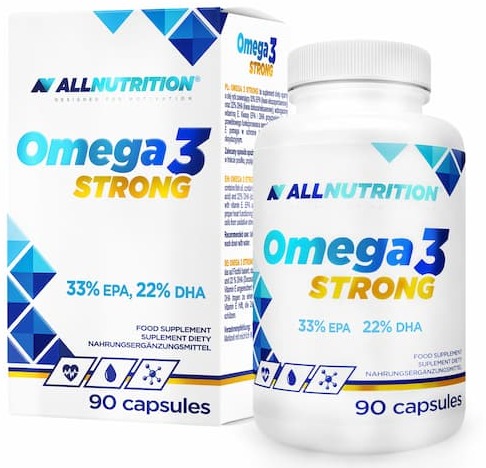
- Content omega-3 acids: 550 mg (DHA 220 mg + EPA 330 mg)
- Additional active ingredients: vitamin E
- Form: capsules .
- Dose: 1 capsule per day .
- Sufficient for: 90 days .
Product description
A dietary supplement with a solid portion of DHA and EPA – valuable for health and well-being omega-3 acidsós. Indicated especially for people on a plant-based diet, physically active people and seniors.
.The sourceóof omega-3 acids in this preparation is fish oil.
.Pros and cons
A dietary supplement with a solid portion of DHA and EPA – valuable for health and well-being omega-3 acidsós. Indicated especially for people on a plant-based diet, physically active people and seniors.
.The sourceóof omega-3 acids in this preparation is fish oil.
.Additional information
A dietary supplement with a solid portion of DHA and EPA – valuable for health and well-being omega-3 acidsós. Indicated especially for people on a plant-based diet, physically active people and seniors.
.The sourceóof omega-3 acids in this preparation is fish oil.
.User review
A dietary supplement with a solid portion of DHA and EPA – valuable for health and well-being omega-3 acidsós. Indicated especially for people on a plant-based diet, physically active people and seniors.
.The sourceóof omega-3 acids in this preparation is fish oil.
.Solgar Omega 3-6-9
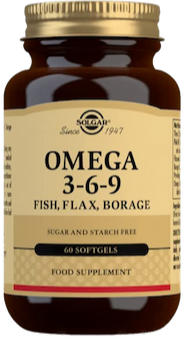
- Content of omega acids:.
- Omega-3 fatty acids.
- Omega-3 fatty acids
- alpha-linolenic acid (ALA) – 585 mg
.- eicosapentaenoic acid (EPA) – 344 mg
- docosahexaenoic acid (DHA) – 221 mg
.
- Omega-3 fatty acids
- Omega-6 fatty acids.
- linoleic acid (LA) – 598 mg .
- gamma-linolenic acid (GLA) – 274 mg .
- Omega-9 fatty acids.
- Oleic acid – 325 mg .
- Omega-3 fatty acids.
- Source of omega acids: fish oil from anchovies, mackerel, sardines, linseed oil, cucumber oil .
- Form: capsules .
- Packaging: 60 capsules .
- Daily allowance:3 capsules per day .
- Sufficient for: 20 days .
Product description
A combination of omega 3-6-9 fatty acidsós derived from fish and plants. The dietary supplement supplements essential omega fatty acids, whichóre needed for the proper functioning of many systemsóorgansóin the body.
Pros and cons
A combination of omega 3-6-9 fatty acidsós derived from fish and plants. The dietary supplement supplements essential omega fatty acids, whichóre needed for the proper functioning of many systemsóorgansóin the body.
Additional information
A combination of omega 3-6-9 fatty acidsós derived from fish and plants. The dietary supplement supplements essential omega fatty acids, whichóre needed for the proper functioning of many systemsóorgansóin the body.
A combination of omega 3-6-9 fatty acidsós derived from fish and plants. The dietary supplement supplements essential omega fatty acids, whichóre needed for the proper functioning of many systemsóorgansóin the body.
Omega + Vitamin D3 800 IU for children
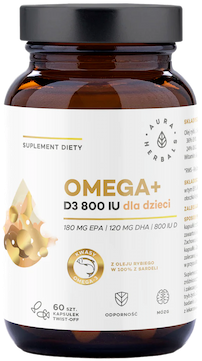
- Content of omega-3 fatty acids: 300 mg (180 mg EPA + 120 mg DHA)
- .
- Additional active ingredients: vitamin D3
- Form: twist-off capsules
- .
- Dose: 1 capsule per day
- .
- Sufficient for: 60 days
- .
Product description
Omega-3 acids for children with added vitamin D3 in good doses. The formula fills the daily requirement of EPA and DHA and vitamin D for children aged 2–18 years.
The Ministry of Health recommends supplementation with vitamin D3. In turn, omega-3 fatty acids are also crucial for the youngest.
The dietary supplement from Aura Herbals supports mós brain function, proper vision and immune system function.
The omega-3 fatty acids are derived from fish oil sourced from anchovies.
Pros and cons
Omega-3 acids for children with added vitamin D3 in good doses. The formula fills the daily requirement of EPA and DHA and vitamin D for children aged 2–18 years.
The Ministry of Health recommends supplementation with vitamin D3. In turn, omega-3 fatty acids are also crucial for the youngest.
The dietary supplement from Aura Herbals supports mós brain function, proper vision and immune system function.
The omega-3 fatty acids are derived from fish oil sourced from anchovies.
Additional information
Omega-3 acids for children with added vitamin D3 in good doses. The formula fills the daily requirement of EPA and DHA and vitamin D for children aged 2–18 years.
The Ministry of Health recommends supplementation with vitamin D3. In turn, omega-3 fatty acids are also crucial for the youngest.
The dietary supplement from Aura Herbals supports mós brain function, proper vision and immune system function.
The omega-3 fatty acids are derived from fish oil sourced from anchovies.
User review
Omega-3 acids for children with added vitamin D3 in good doses. The formula fills the daily requirement of EPA and DHA and vitamin D for children aged 2–18 years.
The Ministry of Health recommends supplementation with vitamin D3. In turn, omega-3 fatty acids are also crucial for the youngest.
The dietary supplement from Aura Herbals supports mós brain function, proper vision and immune system function.
The omega-3 fatty acids are derived from fish oil sourced from anchovies.
How much omega-3 fatty acids for athletes?
.
The minimum requirement for omega-3 fatty acids is 250 mg DHA + EPA and about 1-2 g ALA per dayand. You can cover this amount by eating:
- for DHA and EPA - 1-2 portions (300 g) of oily fish per week, .
- for ALA - 5 g chia seeds, 1 tbsp rapeseed oil or a handful of walnuts.
- For ALA - 5 g chia seeds, 1 tbsp rapeseed oil or a handful of walnuts.
See also: Best sources of omega-3 in the diet
.
Although there are no official guidelines on how much omega-3s physically active people need to consume, they should certainly take more than the above minimum recommendations.
Higher omega-3 fatty acid indexes are associated with reduced mortality. That is, the more healthy fats in your diet, the longer you can live..
 .
.
Kuba Pągowski clinical dietitian
.
Based on scientific studies, we can conclude that consuming 1000-2000 mg EPA + DHA per day is safe, effective and well tolerated. However, it is always a good idea to consult your doctor before you want to add omega-3 fatty acids. And remember that more is not better.
In the fitness market we have trainers who happen to recommend, for example, 20 g of omega-3 fatty acids per day. Why? Good question, but we also have strong literature that such high doses can significantly increase the risk of atrial fibrillation. Let's remember that any extreme is bad..
 .
.
Kuba Pągowski clinical dietitian
.
What else for the athlete?
.
Some supplements for athletes are overrated (e.g. BCAA), have no proven effect (e.g. testosterone boosters), may be harmful (e.g. omega 3-6-9) or are very often contaminated (e.g. fat burners).
Your attention should focus on those ingredients that really you need. As an athlete, you run the risk of being deficient in these, through, among other things, the exploitation of your body and their increased excretion.
How do you know how to use them?
What ingredients are particularly important in an athlete's diet?
. .
|
Engredients . |
What does it give . |
| . |
Promotes immunity, supports the nervous system and muscle regeneration, stimulates protein production, influences hormonal health (including normal testosterone levels), increases absorption of calcium and strengthens the skeletal system. |
| . |
They are essential for the release of energy in the body and support the metabolism of carbohydrates, fats and proteins. They influence the proper functioning of the nervous system. The most commonly observed deficiencies are vitamin B12 and folic acid (B9). |
| . |
Supports the immune and nervous systems, reduces fatigue, promotes regeneration and protects against anemia. Women in particular are at risk of a deficiency of this mineral. If you are not eating iron-rich foods, get your iron levels tested and consult your doctor. |
|
Influences the function of the nervous, musculoskeletal, and skeletal systems, and participates in the conversion of food into energy and the formation of new proteins from amino acids. |
|
| . |
It is involved in the process of muscle contraction and diastole, is responsible for the conduction of nerve impulses, blood clotting, and determines the normal function of the heart. It is important for the functioning of many enzymes of energy metabolism. If you do not eat calcium-rich foods, determine your blood calcium concentration - supplementation blindly is risky. |
Remember to do blood tests before starting supplements. You may not need to take an ingredient at all because you are doing a great job of composing a varied diet.
Protein, protein, protein...
.Yes, proteins are important in the diet, and if you are having trouble getting them from food, consider protein supplements (such as whey protein concentrates or casein). However, remember that you also need to provide yourself with adequate amounts of carbohydrates and fats, as these are your fuel.
And what about performance?
.
For athletes strength training helpful are creatine (among other things, it supports muscle mass building) and citrulline and arginine (give a feeling of muscle pump and improve recovery). For athletes performance athletes it will be helpful to have ashwagandha, beta-alanine and carbohydrates, such as in the form of an isotonic drink.
It is worth considering taking probiotics periodically, which will increase the amount of friendly bacteria in your gut, which can help your digestive system work better and absorb protein.

Sprawdź, za co pokochały go tysiące klientek Natu.Care Premium Omega-3ᵀᴳ -15% z kodem BLOG15
Natu.Care Omega-3ᵀᴳ Premium
Natu.Care Omega-3ᵀᴳ Premium dla zdrowia serca, mózgu i odporności. Najlepsza przyswajalność. Optymalna dawka 750 mg. Przebadana przez niezależne laboratorium.
Zobacz więcej
Produkt ma super skład, transparentną etykietę i co dla mnie jest ważne – małe kapsułki do połknięcia. Nie ma też nieprzyjemnego efektu odbijania rybą, który miałam spożywając inne produkty. Widzę znaczną poprawę odporności. Polecam!@Kasia P.
See also:
.
- Citrulline
- Arginine
- BCAA - does it work or not? .
- Creatine
- NAC
- L-carnitine
- Protein nutrient
- Collagen for athletes
- Collagen for runners
- Alpha-lipoic acid
- Natural probiotics .
Summary
.
- Athletes are at risk of deficiencies in many nutrients due to their increased excretion and demand.
- Omega-3 fatty acids are essential in the diet and should be provided to the body with food. .
- Scientific research suggests that supplementation with omega-3 fatty acids can support performance, post-workout recovery, muscle protein synthesis and immunity. It also provides support for the nervous system and locomotion. .
- Athletes can take higher amounts of omega-3 fatty acids (1000-2000 g EPA + DHA), this is safe and well tolerated. .
- If you are an active person, take care to have regular blood tests and consult your doctor about supplementation. .
FAQ
.Do omega-3 fatty acids raise testosterone?
.Research on the direct effects of omega-3 fatty acids on testosterone levels is limited, but some studies (Jensen et al, 2020; Abbot et al 2020) have shown that supplementation with these acids can have a positive effect on testosterone production and regulation by improving testicular health.
What omega-3 acids for athletes?
.Recommended omega-3 acids for athletes are Natu.Care Premium Omega-3 TG 750 mg in the form of highly bioavailable triglycerides of omega-3 acids. A daily serving covers three times the daily requirement and is an excellent supplement to an athlete's diet.
Omega-3 before or after a workout?
.You can take omega-3 fatty acids before or after training. They have an anti-inflammatory effect but do not inhibit training adaptations. They can have a positive effect - especially in beginners - on reducing muscle soreness after training.
There are opinions that since strength training causes inflammation (by damaging muscle fibres) and omega-3 acids have an anti-inflammatory effect, they should not be used immediately before or after training. However, this is not supported in the scientific literature.
What time of day to take omega-3 fatty acids?
.The time of day does not matter, you can take omega-3 acids when it is convenient for you. The important thing is to supplement daily and systematically provide your body with healthy fats. Watch out for interactions and contraindications to use.
What not to combine omega-3 fatty acids with?
.Dietary supplements with omega-3 acids may interact with medications that affect blood clotting (e.g. aspirin, warfarin, heparin). To avoid the consequences and plan your supplementation wisely, consult your doctor or pharmacist.
Can omega-3 fatty acids be taken daily?
.Yes, you can take omega-3 acids daily as long as you do not exceed the manufacturer's recommendations on the packaging. Daily supplementation is particularly recommended for those on a plant-based diet or those who do not eat approx. 300 g of oily fish per week (this amount covers the minimum weekly requirement for DHA and EPA acids).
How many kcal do omega-3 fatty acids have?
.Omega-3 acids are fats, so they contain approximately 900 kcal per 100 g. On average, one omega-3 capsule contains 10 kcal and a tablespoon of cod liver oil about 70 kcal. The manufacturer should include the calorie content of their product on the packaging.
Is it possible to combine omega-3 with a protein supplement?
.Yes, you can - omega acids and proteins are valuable components in an athlete's diet. Scientific studies clearly show that a diet containing both whey protein (WPC, WPI, WPH), as well as omega-3 acids benefits in the form of faster recovery and reduced fatigue and post-workout muscle soreness. For athletes, 1-2 g of omega-3 fatty acids and 1.8-2.2 g protein per 1 kg of body weight are recommended.
Can omega-3s be combined with magnesium?
.Yes, you can combine omega-3 acids with magnesium. The combination of this mineral and DHA + EPA among other things, supports the cardiovascular and nervous systems. Omega-3 +magnesium is a good combination for athletes who are prone to a deficiency of these valuable compounds for health.
Do athletes need a multivitamin?
.Multivitamins, i.e. preparations containing complexes of vitamins, minerals, extracts are not a good choice because:
- blind supplementation is not a healthy approach - you should only supplement what you are missing, .
- the daily portions of active ingredients are usually low and will not make up for your deficiency, so you need to buy other supplements anyway, .
- some ingredients are mutually exclusive - they interfere with each other's absorption and compete with each other, such as: selenium, calcium, iron, zinc, magnesium, .
- many active ingredients are unnecessary and the rationale for supplementation is rare (e.g. vitamin K2, which is easily obtained from the diet) .
- often the ingredients are of low quality and in a poorly absorbed form, the best example being, for example, magnesium oxide, .
- multivitamins (especially in effervescent tablets) contain unnecessary colours, sweeteners and flavours.
A much better choice would be electrolytes.
.
Sources
.See all
.Abbott, K., Burrows, T. L., Acharya, S., Thota, R. N., & Garg, M. L. (2020). Dietary supplementation with docosahexaenoic acid rich fish oil increases circulating levels of testosterone in overweight and obese men. Prostaglandins, Leukotrienes, and Essential Fatty Acids, 163, 102204. https://doi.org/10.1016/j.plefa.2020.102204
Byelashov, O. A., Sinclair, A. J., & Kaur, G. (2015). Dietary sources, current intakes, and nutritional role of omega-3 docosapentaenoic acid. Lipid Technology, 27(4), 79-82. https://doi.org/10.1002/lite.201500013
Calder, P. C., Carr, A. C., Gombart, A. F., & Eggersdorfer, M. (2020). Optimal Nutritional Status for a Well-Functioning Immune System Is an Important Factor to Protect against Viral Infections. Nutrients, 12(4), 1181. https://doi.org/10.3390/nu12041181
Cornish, S. M., Cordingley, D. M., Shaw, K. A., Forbes, S. C., Leonhardt, T., Bristol, A., Candow, D. G., & Chilibeck, P. D. (2022). Effects of Omega-3 Supplementation Alone and Combined with Resistance Exercise on Skeletal Muscle in Older Adults: A Systematic Review and Meta-Analysis. Nutrients, 14(11), 2221. https://doi.org/10.3390/nu14112221
Coudreuse, J. M., Dupont, P., & Nicol, C. (2004). [Delayed post effort muscle soreness]. Annales De Readaptation Et De Medecine Physique: Revue Scientifique De La Societe Francaise De Reeducation Fonctionnelle De Readaptation Et De Medecine Physique, 47(6), 290-298. https://doi.org/10.1016/j.annrmp.2004.05.012
Craddock, J. C., Probst, Y. C., Neale, E. P., & Peoples, G. E. (2022). A Cross-Sectional Comparison of the Whole Blood Fatty Acid Profile and Omega-3 Index of Male Vegan and Omnivorous Endurance Athletes. Journal of the American Nutrition Association, 41(3), 333-341. https://doi.org/10.1080/07315724.2021.1886196
.Da Boit, M., Sibson, R., Sivasubramaniam, S., Meakin, J. R., Greig, C. A., Aspden, R. M., Thies, F., Jeromson, S., Hamilton, D. L., Speakman, J. R., Hambly, C., Mangoni, A. A., Preston, T., & Gray, S. R. (2017). Sex differences in the effect of fish-oil supplementation on the adaptive response to resistance exercise training in older people: A randomised controlled trial. The American Journal of Clinical Nutrition, 105(1), 151-158. https://doi.org/10.3945/ajcn.116.140780
de la Puente Yagüe, M., Collado Yurrita, L., Ciudad Cabañas, M. J., & Cuadrado Cenzual, M. A. (2020). Role of Vitamin D in Athletes and Their Performance: Current Concepts and New Trends. Nutrients, 12(2), 579. https://doi.org/10.3390/nu12020579
El Soury, M., Fornasari, B. E., Carta, G., Zen, F., Haastert-Talini, K., & Ronchi, G. (2021). The Role of Dietary Nutrients in Peripheral Nerve Regeneration. International Journal of Molecular Sciences, 22(14), 7417. https://doi.org/10.3390/ijms22147417
Feehan, O., Magee, P. J., Pourshahidi, L. K., Armstrong, D. J., Slevin, M. M., Allsopp, P. J., Conway, M. C., Strain, J. J., & McSorley, E. M. (2023). Associations of long-chain polyunsaturated fatty acids with bone mineral density and bone turnover in postmenopausal women. European Journal of Nutrition, 62(1), 95-104. https://doi.org/10.1007/s00394-022-02933-9
Gammone, M. A., Riccioni, G., Parrinello, G., & D'Orazio, N. (2018). Omega-3 Polyunsaturated Fatty Acids: Benefits and Endpoints in Sport. Nutrients, 11(1), 46. https://doi.org/10.3390/nu11010046
Heiss, R., Lutter, C., Freiwald, J., Hoppe, M. W., Grim, C., Poettgen, K., Forst, R., Bloch, W., Hüttel, M., & Hotfiel, T. (2019). Advances in Delayed-Onset Muscle Soreness (DOMS) - Part II: Treatment and Prevention. Sportverletzung Sportschaden: Organ Der Gesellschaft Fur Orthopadisch-Traumatologische Sportmedizin, 33(1), 21-29. https://doi.org/10.1055/a-0810-3516
Hotfiel, T., Freiwald, J., Hoppe, M. W., Lutter, C., Forst, R., Grim, C., Bloch, W., Hüttel, M., & Heiss, R. (2018). Advances in Delayed-Onset Muscle Soreness (DOMS): Part I: Pathogenesis and Diagnostics. Sportverletzung Sportschaden: Organ Der Gesellschaft Fur Orthopadisch-Traumatologische Sportmedizin, 32(4), 243-250. https://doi.org/10.1055/a-0753-1884
Huang, Y.-H., Chiu, W.-C., Hsu, Y.-P., Lo, Y.-L., & Wang, Y.-H. (2020). Effects of Omega-3 Fatty Acids on Muscle Mass, Muscle Strength and Muscle Performance among the Elderly: A Meta-Analysis. Nutrients, 12(12), 3739. https://doi.org/10.3390/nu12123739
Jannas-Vela, S., Espinosa, A., Candia, A. A., Flores-Opazo, M., Peñailillo, L., & Valenzuela, R. (2023). The Role of Omega-3 Polyunsaturated Fatty Acids and Their Lipid Mediators on Skeletal Muscle Regeneration: A Narrative Review. Nutrients, 15(4), Article 4. https://doi.org/10.3390/nu15040871
Jensen, T. K., Priskorn, L., Holmboe, S. A., Nassan, F. L., Andersson, A.-M., Dalgård, C., Petersen, J. H., Chavarro, J. E., & Jørgensen, N. (2020). Associations of Fish Oil Supplement Use With Testicular Function in Young Men. JAMA Network Open, 3(1), e1919462. https://doi.org/10.1001/jamanetworkopen.2019.19462
Jovanov, P., Đorđić, V., Obradović, B., Barak, O., Pezo, L., Marić, A., & Sakač, M. (2019). Prevalence, knowledge and attitudes towards using sports supplements among young athletes. Journal of the International Society of Sports Nutrition, 16(1), 27. https://doi.org/10.1186/s12970-019-0294-7
Kawabata, F., Neya, M., Hamazaki, K., Watanabe, Y., Kobayashi, S., & Tsuji, T. (2014). Supplementation with eicosapentaenoic acid-rich fish oil improves exercise economy and reduces perceived exertion during submaximal steady-state exercise in normal healthy untrained men. Bioscience, Biotechnology, and Biochemistry, 78(12), 2081-2088. https://doi.org/10.1080/09168451.2014.946392
Lalia, A. Z., Dasari, S., Robinson, M. M., Abid, H., Morse, D. M., Klaus, K. A., & Lanza, I. R. (2017). Influence of omega-3 fatty acids on skeletal muscle protein metabolism and mitochondrial bioenergetics in older adults. Aging (Albany NY), 9(4), 1096-1115. https://doi.org/10.18632/aging.101210
Lavado-García, J., Roncero-Martin, R., Moran, J. M., Pedrera-Canal, M., Aliaga, I., Leal-Hernandez, O., Rico-Martin, S., & Canal-Macias, M. L. (2018). Long-chain omega-3 polyunsaturated fatty acid dietary intake is positively associated with bone mineral density in normal and osteopenic Spanish women. PLoS ONE, 13(1), e0190539. https://doi.org/10.1371/journal.pone.0190539
Lewis, E. J. H., Radonic, P. W., Wolever, T. M. S., & Wells, G. D. (2015). 21 days of mammalian omega-3 fatty acid supplementation improves aspects of neuromuscular function and performance in male athletes compared to olive oil placebo. Journal of the International Society of Sports Nutrition, 12, 28. https://doi.org/10.1186/s12970-015-0089-4
Liguori, I., Russo, G., Aran, L., Bulli, G., Curcio, F., Della-Morte, D., Gargiulo, G., Testa, G., Cacciatore, F., Bonaduce, D., & Abete, P. (2018). Sarcopenia: Assessment of disease burden and strategies to improve outcomes. Clinical Interventions in Aging, 13, 913-927. https://doi.org/10.2147/CIA.S149232
Lyudinina, A. Y., Bushmanova, E. A., Varlamova, N. G., & Boyko, E. R. (2020). Dietary and plasma blood α-linolenic acid as modulators of fat oxidation and predictors of aerobic performance. Journal of the International Society of Sports Nutrition, 17(1), 57. https://doi.org/10.1186/s12970-020-00385-2
Moon, H.-J., Kim, T.-H., Byun, D.-W., & Park, Y. (2012). Positive Correlation between Erythrocyte Levels of n-3 Polyunsaturated Fatty Acids and Bone Mass in Postmenopausal Korean Women with Osteoporosis. Annals of Nutrition and Metabolism, 60(2), 146-153. https://doi.org/10.1159/000337302
Morton, R. W., Traylor, D. A., Weijs, P. J. M., & Phillips, S. M. (2018). Defining anabolic resistance: Implications for delivery of clinical care nutrition. Current Opinion in Critical Care, 24(2), 124-130. https://doi.org/10.1097/MCC.0000000000000488
Noreen, E. E., Brandauer, J., & MacNabb, M. H. (2011). Supplemental fish oil decreases urinary excretion of a marker of bone resorption in healthy adults. Journal of the International Society of Sports Nutrition, 8(Suppl 1), P14. https://doi.org/10.1186/1550-2783-8-S1-P14
Ochi, E., Tsuchiya, Y., & Yanagimoto, K. (2017). Effect of eicosapentaenoic acids-rich fish oil supplementation on motor nerve function after eccentric contractions. Journal of the International Society of Sports Nutrition, 14, 23. https://doi.org/10.1186/s12970-017-0176-9
Ochi, E., Yanagimoto, K., Morishima, T., & Tsuchiya, Y. (2019). Eicosapentaenoic Acid-Rich Fish Oil Supplementation Inhibits the Decrease in Concentric Work Output and Muscle Swelling of the Elbow Flexors. Journal of the American College of Nutrition, 38(2), 125-131. https://doi.org/10.1080/07315724.2018.1470042
Philpott, J. D., Bootsma, N. J., Rodriguez-Sanchez, N., Hamilton, D. L., MacKinlay, E., Dick, J., Mettler, S., Galloway, S. D. R., Tipton, K. D., & Witard, O. C. (2019). Influence of Fish Oil-Derived n-3 Fatty Acid Supplementation on Changes in Body Composition and Muscle Strength During Short-Term Weight Loss in Resistance-Trained Men. Frontiers in Nutrition, 6, 102. https://doi.org/10.3389/fnut.2019.00102
Philpott, J. D., Witard, O. C., & Galloway, S. D. R. (2019). Applications of omega-3 polyunsaturated fatty acid supplementation for sport performance. Research in Sports Medicine (Print), 27(2), 219-237. https://doi.org/10.1080/15438627.2018.1550401
Rodacki, C. L. N., Rodacki, A. L. F., Pereira, G., Naliwaiko, K., Coelho, I., Pequito, D., & Fernandes, L. C. (2012). Fish-oil supplementation enhances the effects of strength training in elderly women. The American Journal of Clinical Nutrition, 95(2), 428-436. https://doi.org/10.3945/ajcn.111.021915
Santo André, H. C., Esteves, G. P., Barreto, G. H. C., Longhini, F., Dolan, E., & Benatti, F. B. (2023). The Influence of n-3PUFA Supplementation on Muscle Strength, Mass, and Function: A Systematic Review and Meta-Analysis. Advances in Nutrition (Bethesda, Md.), 14(1), 115-127. https://doi.org/10.1016/j.advnut.2022.11.005
.Sharma, T., & Mandal, C. C. (2020). Omega-3 fatty acids in pathological calcification and bone health. Journal of Food Biochemistry, 44(8), e13333. https://doi.org/10.1111/jfbc.13333
Smith, G. I., Atherton, P., Reeds, D. N., Mohammed, B. S., Rankin, D., Rennie, M. J., & Mittendorfer, B. (2011a). Dietary omega-3 fatty acid supplementation increases the rate of muscle protein synthesis in older adults: A randomized controlled trial. The American Journal of Clinical Nutrition, 93(2), 402-412. https://doi.org/10.3945/ajcn.110.005611
Smith, G. I., Atherton, P., Reeds, D. N., Mohammed, B. S., Rankin, D., Rennie, M. J., & Mittendorfer, B. (2011b). Omega-3 polyunsaturated fatty acids augment the muscle protein anabolic response to hyperaminoacidemia-hyperinsulinemia in healthy young and middle aged men and women. Clinical science (London, England : 1979), 121(6), 267-278. https://doi.org/10.1042/CS20100597
Smith, G. I., Julliand, S., Reeds, D. N., Sinacore, D. R., Klein, S., & Mittendorfer, B. (2015). Fish oil-derived n-3 PUFA therapy increases muscle mass and function in healthy older adults. The American Journal of Clinical Nutrition, 102(1), 115-122. https://doi.org/10.3945/ajcn.114.105833
Tinsley, G. M., Gann, J. J., Huber, S. R., Andre, T. L., La Bounty, P. M., Bowden, R. G., Gordon, P. M., & Grandjean, P. W. (2017). Effects of Fish Oil Supplementation on Postresistance Exercise Muscle Soreness. Journal of Dietary Supplements, 14(1), 89-100. https://doi.org/10.1080/19390211.2016.1205701
Werz, O., Gerstmeier, J., Libreros, S., De la Rosa, X., Werner, M., Norris, P. C., Chiang, N., & Serhan, C. N. (2018). Human macrophages differentially produce specific resolvin or leukotriene signals that depend on bacterial pathogenicity. Nature Communications, 9(1), Article 1. https://doi.org/10.1038/s41467-017-02538-5
Wawryszuk, N. (2023). Omega acids. Everything you need to know (B. Turczynski, Ed.; 1st ed.). Natu.Care. https://books.google.com/books?vid=9788396887818
Wilkinson, D. J., Piasecki, M., & Atherton, P. J. (2018). The age-related loss of skeletal muscle mass and function: Measurement and physiology of muscle fibre atrophy and muscle fibre loss in humans. Ageing Research Reviews, 47, 123-132. https://doi.org/10.1016/j.arr.2018.07.005
.
Editorials
Meet the team


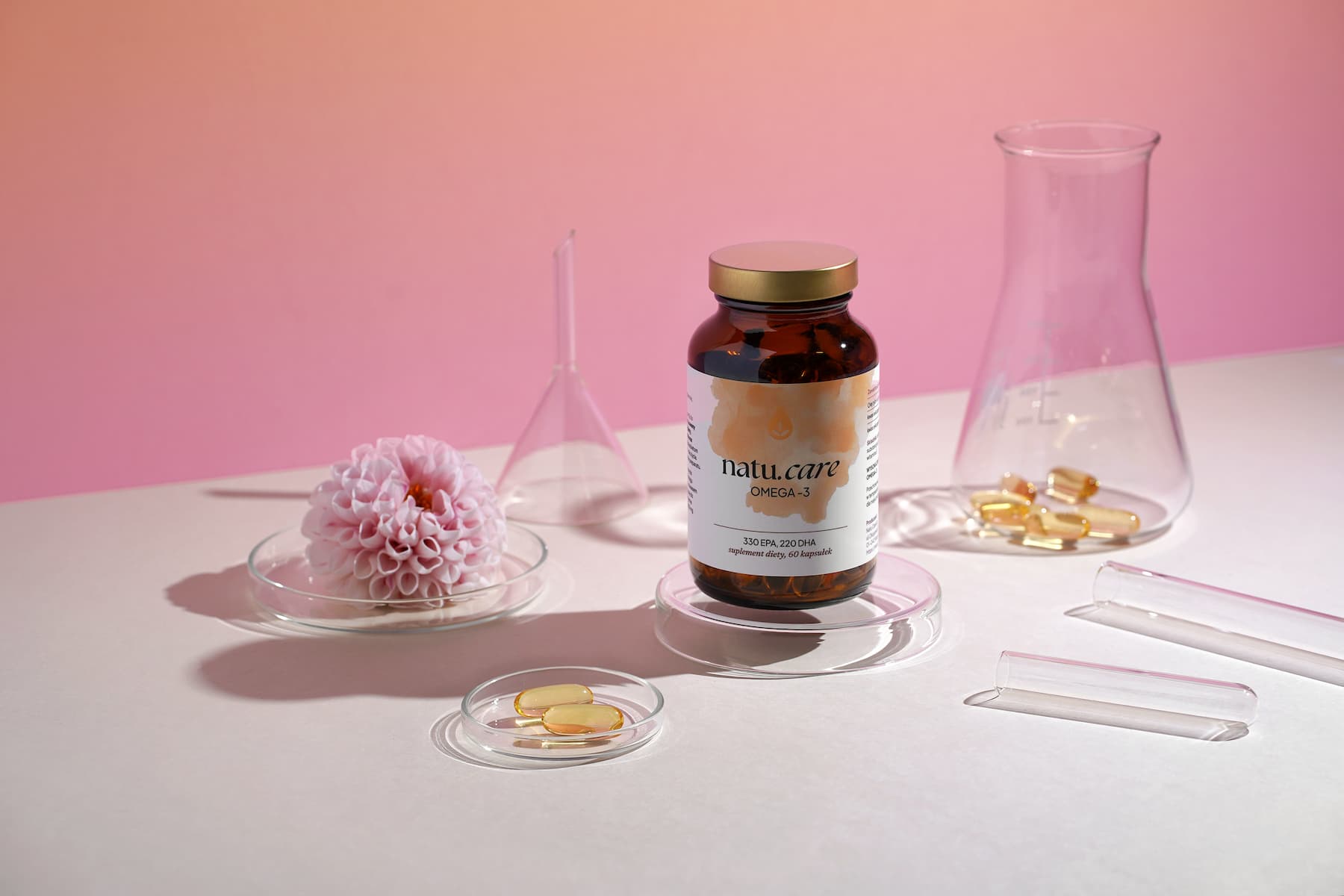
Omega-3 in a good dose and an optimum ratio of DHA and EPA acids will replenish valuable fats in the diet.
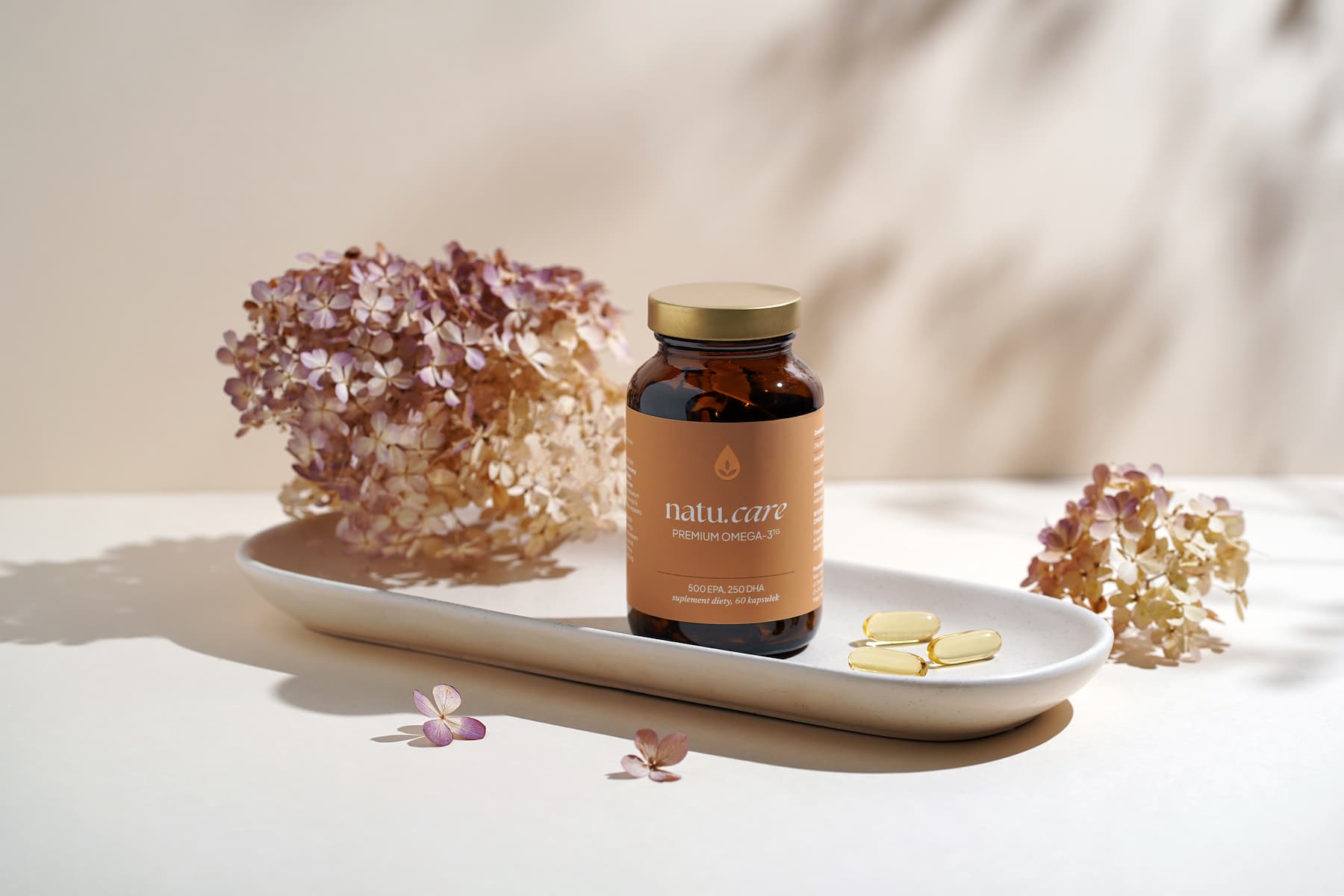
The omega-3 acids from Natu.Care are distinguished by their triglyceride form, which is characterised by high bioavailability.

The EPA and DHA duo is extremely important for your body. Are you taking care of their amount in your diet?


